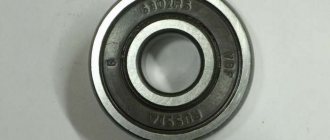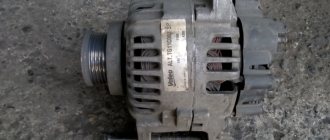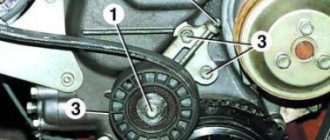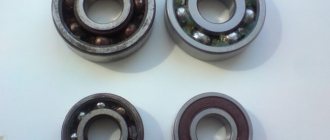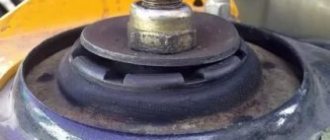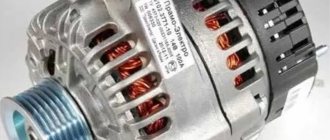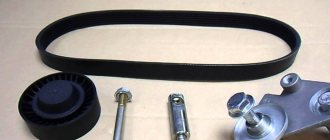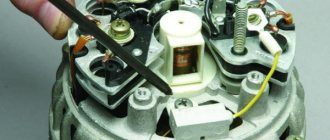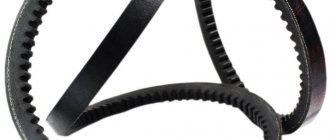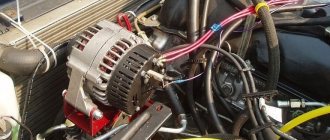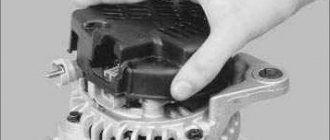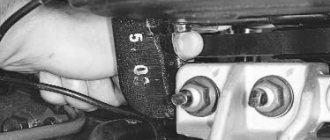Why does noise occur?
Although the generator is one of the most stable mechanisms, no car is immune from its breakdown. Often the malfunction is accompanied by noise coming from the bearings. If the driver hears a squeak, this indicates poor belt tension. In this case, the situation will be corrected by stretching it. separately about how to check the functionality of other elements of the generator .
Bearing wear is always indicated by a hum. If the driver begins to hear a similar noise from under the hood, do not delay repairs. The reason is that without a generator the car will not go far, because the battery in the vehicle's electrical system acts as a starting element. Its charge is not enough to drive.
A worn bearing begins to make noise because it has a strong connection with the engine crankshaft. The forces are transmitted to it through the pulley. For this reason, the noise will increase with increasing speed.
Why does the belt whistle when cold?
The problem of whistling when cold can have several varieties. A squeak or whistle does not appear when the engine starts, but after a couple of minutes. This problem is easily diagnosed, since after the engine reaches operating temperature, the sound disappears.
The reason for the non-standard behavior of the belt is also hidden in its slippage. The torque transmitted from the crankshaft is not sufficient to spin the pulley. There are several reasons for this problem:
- Inaccurate selection of bearing lubricant for the generator. Due to the compaction of the lubricating fluid consistency at low temperatures outside, the generator pulley is not able to function as usual until the machine’s power unit warms up. At engine operating temperature, the lubricant will defrost and the unpleasant sound will disappear. The solution to the problem will be for the car owner to purchase a lubricant option that is more resistant to temperature changes outside the window.
- Weak tension. This situation is identical to the previous one. Until the engine reaches the required operating temperature, due to low tension, the belt is not able to perform its functions at the required speed and will slip.
The squeaking of the alternator belt when cold can be a sign of serious problems - a jammed pulley. This problem can easily be diagnosed on your own. The car owner should try to turn the specified part by hand. If the attempt does not lead to success, then you will have to either replace the generator or repair the broken part.
How to eliminate generator noise?
There are only two ways out of the situation. The first is the simplest, but at the same time the most expensive. We just buy a new mechanism and drive until the old one “dies”. Then we simply replace it with a new one. It is worth considering that a breakdown can occur at the most inopportune moment, when it is not possible to carry out repairs, but you urgently need to go.
For this reason, as well as for economic reasons, most motorists, after noise appears from the generator, buy new bearings and go to a car service center. Well, or they try to replace the spare part themselves.
Although replacing a part seems simple at first glance, it requires some skill. For this reason, not everyone will be able to do this efficiently without spoiling the mechanism.
How to understand a bearing failure?
First, you should make sure whether the noise is really related to a generator breakdown. Here's how you can verify this:
- We lift the hood and carry out a visual inspection (the design of many cars allows you to see the generator this way). This simple diagnostic will help you see cracks and other damage in the pulley area;
- Sometimes a persistent hum can be eliminated by tightening the fan nut. If the fastening is loose, decent noise can also be created during operation of the mechanism;
- You can disassemble the generator and check its electrical part;
- Poor contact of brushes with rings can create similar noise. In this case, you will also have to remove the device, unscrew the cover and clean each ring on the shaft. In order not to damage the elements, it is better to do this with a soft rag, after moistening it in gasoline. If the hum continues, then it is definitely a bearing;
- The front bearing is checked for play. To do this, the lid swings and turns (the effort should not be great). At this moment, the pulley must be held. The presence of play and uneven rotation (sticking) indicates bearing wear;
- The rear bearing is checked in the same way as the front. To do this, we take hold of the outer element (ring) and try to swing it and unwind it. Play, jerking, knocking and other similar signs indicate that the part needs to be replaced with a new one.
Signs of an unusable generator bearing
In addition to visual diagnostics, indirect signs of failure of one of the bearings (or both at once) are:
- Extraneous noise (for example, knocking, humming or whistling) coming from the mechanism during operation of the power unit;
- The structure becomes very hot in a short period of time;
- The pulley slips;
- The on-board voltmeter records jumps in charging indicators.
Most “symptoms” can only indirectly indicate bearing failures. Often these symptoms are identical to malfunctions of other elements.
Diode bridge
The hum can also come from the diode bridge. To check whether the diode bridge is shorting, you should remove the cover on the back of the unit, remove the diode bridge, and adjust the washers under the clamps with which it is screwed. And if you add an additional puck, it will be even better.
Generator diode bridge
It also happens that a wire falls off the diode bridge. It’s a banal reason, but until you figure it out, you won’t see it.
Low voltage, howling, generator humming — Lada 2113, 1.6 l., 2011 on DRIVE2
Hello! Low voltage in the network haunted me. I decided to do this.
Full size
maximum at idle
I cleaned the masses wherever I found them, all that remained was to deal with the generator, it so happened that the nut on the generator was stuck and did not want to come off, in the end I tore it off along with the capacitor. I had to remove the generator. This is not a simple thing; it’s better to remember all the manipulations well.
Full size
top view
After removal, we check the integrity of the diodes; if there is a burnt one, it will be visible, but if there is dirt everywhere, this is normal.
And here is the most important point, I’m getting ahead of myself and I’ll say that this bushing is the problem with everything.
Full size
It is located between the terminals and the diode bridge
Full size
It looked like this.
It's very rusty.
Imagine someone is fanatical about keeping the battery terminals clean, but completely forgets about the cleanliness in this place. If you remove this wire from the generator altogether, the car will not show any signs of life, as if the battery had been removed from it. Then I collect everything and receive it.
Got upset. I thought that as a result of the assembly, the bearing had knocked somewhere and started buzzing. I went to a service center in my area. We put this lid on.
Full size
Krykha
Nothing helped.
The generator hums, gets very hot, the voltage jumps, the car stalls
. It became quieter purely because the bearing still needed to be changed and it still rustled a little. I searched through a huge number of forums and found nothing. When this happens, people don’t know where to look. I woke up early in the morning and began to carefully look at the photographs, it’s good that I always record almost every step. And I noticed this.
Full size
textolite washer
And then I shuddered, I threw this puck away, I thought what the hell is this? I'll set it to normal. And thereby caused a short circuit in the first circuit of the diode bridge to the bolt that sticks out of the generator. I corrected the situation with this solution.
Full size
Made washers from refractory plastic
And everything worked well. I'm very glad that nothing burned. Learn from my mistake. Always be extremely careful. And here is the result!
Bottom line! Check not only the terminals but also the fastening to the generator, otherwise you are used to installing new brushes and three-levelers!
Full size
Varieties of whistling
It is customary to distinguish whistling by the nature of its occurrence. For example, a whistle may appear only when it is cold, then disappear. Therefore, it is equally important to know how the alternator belt whistles.
Whistling when cold is a common headache for Russian car owners. There are several reasons.
- The grease for the generator bearings is incorrectly selected. Because of this, in cold weather the composition becomes denser, the pulley cannot easily rotate the rotor. Everything goes away as soon as the engine warms up and the lubricant “defrosts”. The solution to this problem is simple - replace the anti-adhesive with a composition that is more cold-resistant.
- Weak belt tension. An engine that is simply not able to start working dynamically “when cold” requires time to warm up. During this period, a weakly tensioned belt lacks the strength to “accelerate” on the pulleys. It slips and whistles, but only until the motor begins to rotate quickly and evenly.
- The pulley itself is jammed. This also only happens “when cold” until the car parts are properly heated. You can check whether the pulley is the cause of the whistling yourself. You need to turn the generator pulley by hand, first taking off the belt. If the pulley rotates slowly or cannot be turned at all, serious repairs and even replacement are needed.
Another option for whistling is noise that occurs only when the engine is under load. This type of whistling is mostly caused by weak belt tension.
Belt whistling: reasons
| CAUSES OF WHISTLING | WHY IS IT WHISTLING? | WHAT TO DO |
| Generator belt | It becomes unusable due to natural wear and tear. Due to grains of sand that fell on the surface of this belt and ate into the grooves. | Check the condition of the belt; if there are cracks on its surface, stuck grains of sand are visible, or threads are sticking out, replace the generator belt immediately. |
| Poor tension | Often, after replacing the alternator belt, it is not tensioned well, resulting in the alternator belt whistling during loads, as well as in wet weather. | Tighten the belt. |
| Pulley or pulleys | If there is wear on the pulleys or they have been changed (installation of non-original pulleys is fraught with whistling and other problems), the appearance of whistling is quite understandable. A loose fit of the poly V-belt to the grooves on the pulley impairs adhesion, as a result the generator belt begins to slip and whistle. | Replacement or repair of pulley(s) |
| Liquid got on the belt | Often the generator belt whistles due to liquid (antifreeze, oil, fuel, etc.) getting on its working surface. | Check for oil and coolant leaks. Eliminate them. Replace the belt. |
| Generator load | Due to the high consumption of electric current, the load on the generator increases, therefore, the resistance of the magnetic field to stator rotation increases. As a result, the generator seems to “slow down” the belt, resulting in surface friction, which is expressed in the form of an unpleasant whistle. | Turn off unnecessary electrical consumers. Check the generator and the entire power circuit. |
| The generator bearing or tension roller is faulty | You can check whether there is play in the generator bearing only by removing it, or try to shake the generator pulley; in this case, the location of the generator plays a big role. | Replace the bearing. If the tension roller is faulty, it will also have to be replaced. |
Forget about fines from cameras! An absolutely legal new product - Traffic Police Camera Jammer, hides your license plates from the cameras that are installed in all cities. More details at the link.
- Absolutely legal (Article 12.2);
- Hides from photo and video recording;
- Suitable for all cars;
- Works through the cigarette lighter connector;
- Does not cause interference to radios and cell phones.
What else can knock, make noise or whistle in the engine after starting?
As you can see, there are quite a lot of reasons for the appearance of knocks and noises. It should be added that when starting a cold engine, especially in winter, increased noise and chirping can be produced by the injection nozzles themselves on units with a pressure fuel injection system.
In some cases, this does not indicate any malfunction, since after a slight warm-up the noise intensity decreases or the extraneous sound completely disappears. A knock can also occur at the moment of starting in the cold due to heavily hardened ICE cushions (the engine is conditionally driven when the starter rotates slightly forward, and after starting it “bounces” back).
You should also not forget about the air conditioning compressor, especially if the engine is started in parallel with the air conditioning turned on or the climate control is activated immediately after starting. The compressor drive or the compressor itself is often the cause of extraneous noise.
The appearance of unnecessary sounds can also be associated with faulty gearboxes or clutch elements. For example, a hum after starting the engine may well come from a release bearing. It should also be taken into account that on many cars the gearbox is located directly in the engine compartment near the internal combustion engine. If it is the transmission that is humming, then this noise needs to be differentiated separately, since the engine and attachments in this case do not require additional diagnostics.
Source
The generator is broken: is it worth continuing driving?
If the initial stage of generator failure (bearing hum) has been detected, theoretically you can still drive. But if possible, it is better to refuse to travel, because this may jeopardize the health of the driver and his passengers. Over time, the hum can develop into a grinding sound, and this is a direct route to a car service center and replacement of the generator. But you can prevent the situation from getting worse and carry out a thorough technical inspection of the car at an early stage of the breakdown. Of course, you need to pay special attention to the generator.
So, if the generator bearing is humming, you should not ignore this problem. The generator is the most important part of the car, and its failure can be the beginning of a series of serious car breakdowns that will cost the driver a pretty penny.
It is better to purchase a multimeter and periodically check the generator, and if there is the slightest malfunction in its operation, contact a car service center and consult with a specialist who, depending on the degree of damage to the generator, will advise what to do next. It is important to remember that it is better to eliminate any breakdown at the initial stage. This way you can save your time and money. In addition, it is better to drive a fully functional car so as not to put yourself and your passengers at risk.
Other causes of whistling
Why does the belt slip? If the load is to blame, then after replacement everything should return to normal. However, the noise continues with the new belt. Some kind of opportunity. No need to panic. It is better to find the reason for all this in the first place.
Experts advise taking the following actions:
- visually inspect the belt, checking it for integrity (even new products today are found to be defective and of poor quality);
- check the shaft and pulleys for cleanliness (oil and other dirt can easily cause whistling);
- diagnose the degree of tension (weak tension also causes noise);
- check the alignment of the pulleys (if two pulleys are not located in relation to each other in the same plane, the belt will not rotate smoothly, thereby touching certain parts with its edges and whistling).
Grinding, knocking or whistling noise when starting the engine
The appearance of extraneous sounds in the engine compartment during or immediately after starting the engine is a reason to diagnose and check the internal combustion engine. Various deviations from the norm can occur as a result of wear of individual elements of attachments, drives, bearings, pulleys or belts. Also, one should not exclude the possibility of breakdown of the power unit itself and its components. Drivers often notice that when starting the engine when cold, a grinding noise is heard, something creaks in the engine, a whistle appears, etc.
Dismantling the VAZ-2110 model generator
Dismantling begins with the following steps:
- removing a special shield that serves as protection against contamination and is located in the engine compartment;
- removing the drive belt;
- disconnecting the wire from the stator, both central and terminal 67, namely:
- removing the protection cap;
- Using a 10mm wrench, remove the nut securing the tip;
- Using a 19-mm socket wrench, unscrew the generator retaining nut with the bracket;
- After removing the long bolt, you get the generator.
It is worth noting that when dismantling the generator, you should be especially careful not to lose the buffer bushing.
Reviews
This is not the first time I come to West Auto on Gogol 51. The guys are all friendly and sociable, masters of their craft. I would like to highlight the master Andrey and the manager Pavel. The guys solved the problem of my car quickly and efficiently. I recommend West Auto to everyone! More details
I really liked the service at the Zapad Auto service and the culture of communication with clients, i.e. with me. Thank you so much! More details
Passing through Ryazan. I am very glad that I came to you. They fixed it quickly. Thank you. More details
